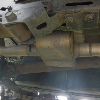Combustion Leak Test Procedure
One method is to use a block tester, also known as a combustion leak tester, to determine if you have exhaust gases in your cooling system. A combustion test kit can be found at your local NAPA, auto parts store. The part number is 700-1006. The price for this part is less than $50.00. Exhaust gases in your cooling system can suggest a head gasket leak, a cracked block, or a warped head, etc. A leaking head gasket can create excessive heat and pressures exceeding the ability of the radiator’s cooling capacity, and should be repaired immediately to avoid additional costly repairs. Head gasket leaks are generally secondary to another problem, such as a clogged or leaking radiator. Make sure you identify and repair or replace the original problem or the vehicle may overheat and cause the head gasket to fail again.
To do the test, add the blue detector fluid to the (block-tester) plastic container according to the directions, and place it onto the radiator filler neck. The squeeze bulb is placed on top of the reservoir and squeezed repeatedly (Some block testers, have a tube that connects to a vacuum line instead of a squeeze bulb). Squeezing the bulb will draw air from the radiator through the test fluid. Block tester fluid is normally blue. Exhaust gases in the cooling system will change the color of the fluid to yellow, indicating a combustion leak. If the fluid remains blue, exhaust gases were not present during the test. The vehicle should be started and at operating temperature before performing the test. Vehicles with head gasket leaks may overheat, and purge hot water and steam out of the radiator. Perform this test, at your own risk, and do not do the test, unless you are experienced and are wearing clothing (don't be naked) and equipment to protect you from burns, or injury.
Sometimes, engines with a head gasket leak show steam, water or white smoke exiting the exhaust pipe. Other symptoms include coolant in the oil, or oil in the radiator coolant.
Radiator pressure test
TEST #1: Pressure Tests for the Cooling System
The first test of the cooling system is done when the engine is cold. A cooling system pressure tester can be installed in place of the radiator cap. Pressure in the cooling system and hot coolant are not something to be treated lightly. Use caution, and never remove the radiator cap from an engine that has been run even for even a short time. After installing the gauge, pump it up to 10 pounds. Look around for leaks if the gauge shows any pressure loss. Common trouble spots include heads, hoses, water pump and rear heater core. If you smell something sweet when you turn the heater fans on, it may be a coolant leak at one of the heater cores, or simply the O-ring at the rear heater valve leaking. Because there is often more then one leak in the system, it is necessary to continue pressure testing until the system holds pressure.
TEST #2
Start the engine cold with no pressure indicated on the gauge. The pressure in the cooling system builds to aprox 7 lbs at normal running temps looking around for leaks. But if the pressure builds quickly to around 15 lbs the pressure is coming from one of the cylinders through the inner head gasket. This can also show up as a coolant pressure loss in the first test. In extreme cases the cylinder can fill with coolant, and will not turn over. This is know as hydraulic lock, and if you suspect this pull the spark plugs and tries to turn the engine again. Pulling the plugs from the engine allows water to escape from the spark plug holes.












